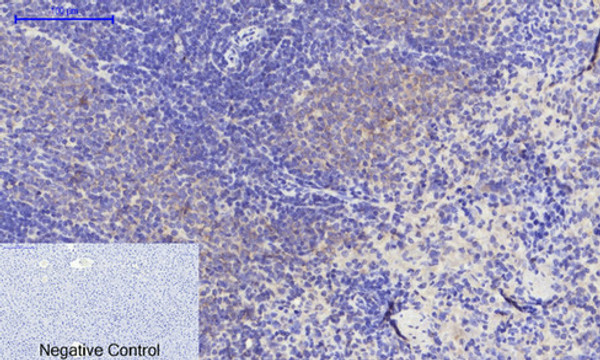| Post Translational Modifications | Oligomerization of the N-terminal ER luminal domain by ER stress promotes EIF2AK3/PERK trans-autophosphorylation of the C-terminal cytoplasmic kinase domain at multiple residues including Thr-982 on the kinase activation loop. Autophosphorylated at Tyr-619 following endoplasmic reticulum stress, leading to activate its activity. Dephosphorylated at Tyr-619 by PTPN1/PTP1B, leading to inactivate its enzyme activity. Phosphorylation at Thr-802 by AKT (AKT1, AKT2 and/or AKT3) inactivates EIF2AK3/PERK. ADP-ribosylated by PARP16 upon ER stress, which increases kinase activity. |
| Function | Metabolic-stress sensing protein kinase that phosphorylates the alpha subunit of eukaryotic translation initiation factor 2 (EIF2S1/eIF-2-alpha) in response to various stress, such as unfolded protein response (UPR). Key effector of the integrated stress response (ISR) to unfolded proteins: EIF2AK3/PERK specifically recognizes and binds misfolded proteins, leading to its activation and EIF2S1/eIF-2-alpha phosphorylation. EIF2S1/eIF-2-alpha phosphorylation in response to stress converts EIF2S1/eIF-2-alpha in a global protein synthesis inhibitor, leading to a global attenuation of cap-dependent translation, while concomitantly initiating the preferential translation of ISR-specific mRNAs, such as the transcriptional activators ATF4 and QRICH1, and hence allowing ATF4- and QRICH1-mediated reprogramming. The EIF2AK3/PERK-mediated unfolded protein response increases mitochondrial oxidative phosphorylation by promoting ATF4-mediated expression of COX7A2L/SCAF1, thereby increasing formation of respiratory chain supercomplexes. In contrast to most subcellular compartments, mitochondria are protected from the EIF2AK3/PERK-mediated unfolded protein response due to EIF2AK3/PERK inhibition by ATAD3A at mitochondria-endoplasmic reticulum contact sites. In addition to EIF2S1/eIF-2-alpha, also phosphorylates NFE2L2/NRF2 in response to stress, promoting release of NFE2L2/NRF2 from the BCR(KEAP1) complex, leading to nuclear accumulation and activation of NFE2L2/NRF2. Serves as a critical effector of unfolded protein response (UPR)-induced G1 growth arrest due to the loss of cyclin-D1 (CCND1). Involved in control of mitochondrial morphology and function. |
| Protein Name | Eukaryotic Translation Initiation Factor 2-Alpha Kinase 3Prkr-Like Endoplasmic Reticulum KinasePancreatic Eif2-Alpha KinaseHspekProtein Tyrosine Kinase Eif2ak3 |
| Database Links | Reactome: R-HSA-381042Reactome: R-HSA-9700645Reactome: R-HSA-9725370Reactome: R-HSA-9755511 |
| Cellular Localisation | Endoplasmic Reticulum MembraneSingle-Pass Type I Membrane ProteinLocalizes To The Localizes To Endoplasmic Reticulum MembraneAlso Present At Mitochondria-Endoplasmic Reticulum Contact SitesWhere It Interacts With Atad3a |
| Alternative Antibody Names | Anti-Eukaryotic Translation Initiation Factor 2-Alpha Kinase 3 antibodyAnti-Prkr-Like Endoplasmic Reticulum Kinase antibodyAnti-Pancreatic Eif2-Alpha Kinase antibodyAnti-Hspek antibodyAnti-Protein Tyrosine Kinase Eif2ak3 antibodyAnti-EIF2AK3 antibodyAnti-PEK antibodyAnti-PERK antibody |
Information sourced from Uniprot.org





























